
THE NEW ENGLAND FLAG
by David B. Martucci

The history of the Pine Tree as a symbol of New England probably predates the european colonial settlements. In eastern Massachusetts and southern New Hampshire and the southern corner of Maine, there once lived a nomadic tribe of Amerindians known as the Penacook. "Penacook" is an Algonquin word meaning "Children of the Pine Tree." The Penacook people have been credited with teaching the Pilgrims, those settlers of the Plymouth Colony of Eastern Massachusetts, much needed survival skills when the colonists were starving to death during the winter of 1621-22. The forests surrounding the settlement were teeming with game and wild foods unfamiliar to the Pilgrims and it was the Penacooks who showed them these new things. According to some accounts, the Penacooks also taught the Pilgrims elementary democracy, which the Penacooks, in turn, had learned from the Five Nations (later six) of the Iroquois Confederacy. The emblem of the Iroquois from the begining of their history to the present day is the "Tree of the Great Peace," a White Pine Tree with an Eagle perched on the top of it.
In 1629, the Plymouth Colony adopted a seal that featured a shield with a Saint George's cross on it, in between the arms of which is a scene repeated four times of a human figure on one knee holding up something in offering (sometimes described as a heart or as a flame) between two trees.
Later, in 1639, the Massachusetts Bay settlers adopted a seal that featured an Amerindian in the center holding an unstrung bow and a down-pointed arrow (symbols of peace and the personal emblems of Samoset, who was one of the two Amerindians who had been captured by the English, taken to England and taught English and returned to New England in time to greet the Pilgrims in their own language, which they thought was a sign from God). Out of his mouth is a ribbon with the caption "Come over and help us" on it and on either side there are two trees. On the left is a Pine Tree and on the right is an Oak Tree. The Oak Tree is a traditional symbol of England; could the Pine be the traditional symbol of the natives of New England?
The Pine Tree has appeared on the Massachusetts Coat of Arms (Reverse) and Naval Flag; the first Seal of New Hampshire (1776); the Coat of Arms, Seal and present Flag of Vermont; the Coat of Arms, Seal, and all the Flags, past and present, of Maine.
Massachusetts Bay Colony was the scene of "The Great Migration" wherein thousands of religious dissenters came over to the New World to make a new life for themselves in the company of "saints" and other Puritans. Right off quick they passed laws regulating social behavior and the observance of the Sabbath and the ministers went to great pains to condemn the traditional "idols" of the established church (not to mention Popery). In 1636, following a sermon by Roger Williams (who was later ousted from Massachusetts for being too liberal and went on to found the Rhode Island Colony) condeming the cross as a symbol of the Anti-Christ, the Governor of the Colony, John Endicott, ordered the Standard Bearers of the Colony to remove the St. Georges Cross from their flags. Before this was done, however, the Great and General Court hauled Endicott in for examination, found that he had "exceeded the lymits of his calling" and punished him by forbiding him from holding public office for one full year! Then they gave the Standard Bearers permission to devise any kind of flag they wanted and, without exception, they removed the crosses from their flags. From that time on until sometime about 50 years later, the unofficial flag of Massachusetts Bay was Red with a White Canton.
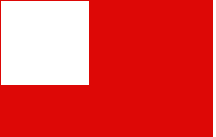
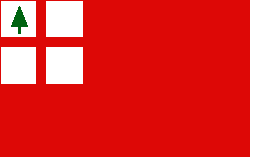
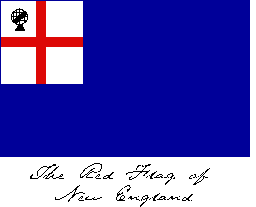
After the Union of England and Scotland, there are a few pictures showing the New England Flag as a Red Ensign with the Union crosses in the Canton and a Pine Tree on a White Canton of the Union.
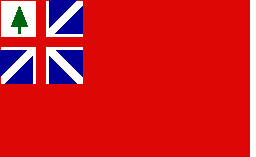
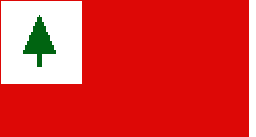
One thing to note; there is a flag being touted as "THE Flag of New England" that is blue with the cross and tree in the canton and six stars in a circle in the fly. This flag has no basis in good history or good vexillology. It was invented by a Flag Company in Ipswich, Massachusetts strictly for commercial purposes and they have sold many to unsuspecting customers. The flag is accompanied by a copyright statement that says "NOT TO BE MANUFACTURED, PRINTED OR REPRODUCED WITHOUT WRITTEN PERMISSION."
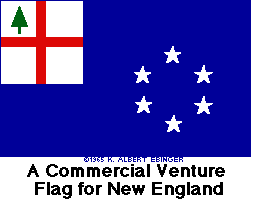
Not Really a Flag of New England
The NEGC responded to NEVA's letter of concern, in part, "In 1998, Mr. Ebinger appeared before the New England Governors' Conference, in Fredericton, New Brunswick, Canada during the annual Conference of New England Governors and Eastern Canadian Premiers and suggested the promotion of New England tourism would benefit from the use of a common symbol, such as his 'New England Flag'. At that meeting, the governors approved a motion to adopt the flag as the 'official emblem of the New England Conference'. They did not make any claims as to its legitimacy as an official or authentic flag of the six state region, nor did they adopt it as the official flag of the region."
Please contact me for further information, references, etc. regarding the Flags of New England and of Maine. There is information about Maine Flags on my Maine Flags pages.
To the New England Vexillological Assn. Page
To the New England Journal of Vexillology Page
To the U.S. Flag History Page